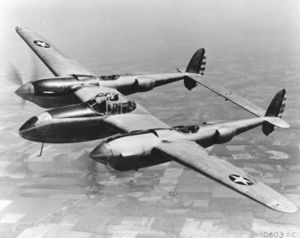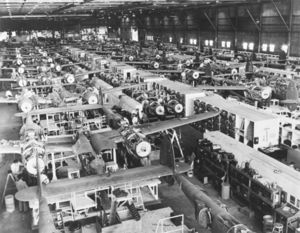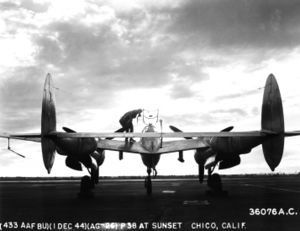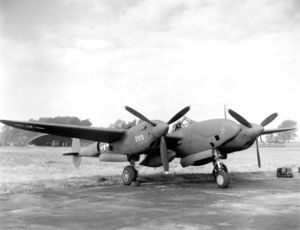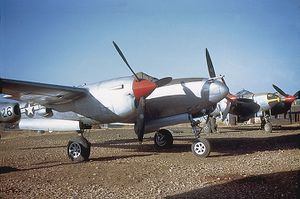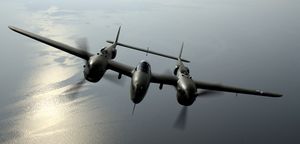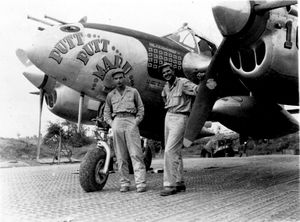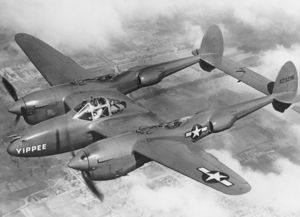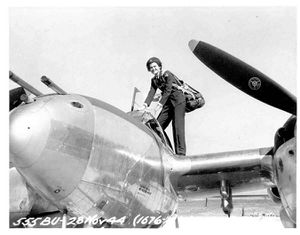PlaneSpottingWorld welcomes all new members! Please gives your ideas at the Terminal.
P-38 Lightning
| P-38 Lightning | |
|---|---|
| Type | Heavy fighter |
| Manufacturer | Lockheed |
| Designed by | Kelly Johnson |
| Maiden flight | 27 January 1939 |
| Introduced | 1941 |
| Retired | 1949 |
| Primary user | United States Army Air Force |
| Produced | 1941-1945 |
| Number built | 10,037[1] |
| Unit cost | US$134,284 when new [2] |
| Variants | Lockheed XP-49 XP-58 Chain Lightning |
The Lockheed P-38 Lightning was a World War II American fighter aircraft. Developed to a United States Army Air Corps requirement, the P-38 had distinctive twin booms with the engines mounted forward and a single, central nacelle containing the pilot and armament. The aircraft was used in a number of different roles, when equipped with droppable fuel tanks under its wings, it was used extensively as a long-range escort fighter. The Lightning was also used for dive bombing, level bombing, ground strafing and photo reconnaissance missions.[3] The P-38 was used most extensively and successfully in the South West Pacific theater, where it was credited with destroying more Japanese aircraft than any other Allied fighter.[citation needed]
Contents
Design and development
Lockheed designed the P-38 in response to a 1937 United States Army Air Corps request for a high-altitude interceptor, capable of 360 miles per hour at altitude of 20,000 feet, (580 km/h at 6100 m).[4] The Bell P-39 Airacobra and the Curtiss P-40 Warhawk were designed to the same requirements.
The Lockheed design team, under the direction of Hall Hibbard and “Kelly” Johnson, considered a range of configurations,[5] before incorporating a number of designs different from existing fighter aircraft. The Lockheed team chose twin booms to accommodate the empennage and the engines, with a central nacelle for the pilot and armament. The nose was designed to carry Browning .50" (12.7mm) machine guns with 200 rounds per gun, two .30" (7.62mm) Brownings with 500 rounds per gun, and an Oldsmobile 37mm cannon with 15 rounds. Clustering all the armament in the nose meant that unlike most other US aircraft with wing-mounted guns, where the trajectories were set up to criss-cross at several points in a "convergence zone," Lightning pilots had to be good shots. For example, Dick Bong would fly directly at his targets to make sure he hit them, in some cases flying through the debris of his target. However, the nose-mounted guns did not suffer from having their useful ranges limited by pattern convergence, meaning good pilots could shoot much farther. A Lightning could reliably hit targets at any range from point-blank to 1,000 yards, whereas other fighters had to pick a single convergence range between 100 and 250 yards. The clustered weapons had a "buzz-saw" effect on the receiving end, making the aircraft effective for strafing as well.
Two 1000 hp (746 kW) turbo-supercharged 12-cylinder Allison V-1710 engines with counter-rotating propellers eliminated the effect of engine torque. The superchargers were positioned in the booms, behind the engines. The design was the first fighter to utilize tricycle undercarriage.[6]
The prototype Lockheed Model 22 won the competition on 23 June 1937 and was contracted to build a prototype XP-38.[7] Lockheed began construction in July 1938 and the XP-38 first flew on 27 January 1939.[8] The 11 February 1939 flight to reposition the aircraft for testing at Wright Field was extended by General Henry "Hap" Arnold, commander of the USAAC, in order to show the performance of the aircraft. It set a cross-continent speed record by flying from California to New York in seven hours and two minutes,[6] but landed short of the Mitchel Field runway in Hempstead, New York and was wrecked. However, on the basis of the record flight, the Air Corps ordered 13 YP-38s on 27 April 1939.[1]
Manufacture of the YP-38s fell behind schedule – the first aircraft was not completed until September 1940, its first flight on 16 September 1940,[9] and the last YP-38 was delivered to the Air Corps in June 1941. They were substantially redesigned and differed greatly in detail from the hand-built XP-38. They were lighter, included changes in engine fit, and the propeller rotation was reversed, with the blades rotating outwards (away) from the cockpit at the top of their arc rather than inwards as before. This improved the aircraft's stability as a gunnery platform.[8]
Test flights revealed tail flutter to be a problem. During high speed flight, especially during dives, the airplanes tail would begin to shake violently and the nose would drop. Once caught in this dive the plance would enter a compressibility stall, and the controls would lock up, leaving the pilot no option but to bail out. During one flight on 4 November 1940, the tail structure fell apart during a high-speed dive; killing YP-38 test pilot, Ralph Virden. On another, USAAC Major Signa Gilkey managed to stay with a YP-38 in a compressibility lockup, riding it out until he got to denser air, where he recovered using elevator trim.[6] The initial fix was to attach mass balances to little booms in the middle of the elevator. The buffeting eventually proved to be due to the straight connection of the wing root to the fuselage pod. A few aerodynamic changes, most particularly the addition of a wing-root fillet, resolved the problem in the P-38J variant. Nonetheless, the external balances were a feature of every P-38 built from then on. [10]
Johnson later recalled:
| “ | I broke an ulcer over compressibility on the P-38 because we flew into a speed range where no one had ever been before, and we had difficulty convincing people that it wasn't the funny-looking airplane itself, but a fundamental physical problem. We found out what happened when the Lightning shed its tail and we worked during the whole war to get 15 more knots [28 km/h] more speed out of the P-38. We saw compressibility as a brick wall for a long time. Then we learned how to get through it.[11] | ” |
Another issue with the P-38 was that both engines were "critical" engines — losing one on takeoff, which often occurred, created "critical torque", rolling the plane towards the live engine's wingtip, rather than the dead engine's. Normal training in flying twin-engine aircraft when losing an engine on takeoff, would be to push the remaining engine to full throttle; in the P-38, the resulting critical torque produced such an uncontrollable asymmetric roll the aircraft would flip over and slam into the ground. Eventually, procedures were devised to allow a pilot to deal with the situation by reducing power on the running engine, feathering the prop on the dead engine, and then increasing power gradually until the aircraft was in stable flight.
The engine sounds were a unique, rather quiet "whuffle," because the exhausts were muffled by the turbochargers of the twin Allison V12s. There were early problems with cockpit temperature regulating; pilots were often too hot in the tropics as the canopy could not be opened without severe buffeting, and were often too cold in northern Europe as the distance of the engines from the cockpit prevented effective heating. However, later variants of the P-38 received modifications that solved this problem.
On 20 September 1939, before the YP-38s had been built and flight tested, the USAAF ordered 66 initial production P-38 Lightnings, 30 of which were delivered to the USAAF in mid-1941. Although not all these aircraft were armed, when they were, they were fitted with four .50s (instead of the two .50 and two .30 of their predecessors) and a 37mm cannon. They also had armor glass, cockpit armor and fluorescent cockpit controls.[12] One was completed with a pressurized cabin on an experimental basis and designated XP-38A.[13] Due to reports the USAAF was receiving from Europe, the remaining 36 in the batch were upgraded with small improvements such as self-sealing tanks and enhanced armor protection to make them combat capable. The USAAF specified that these 36 aircraft were to be designated P-38D. As a result, there never were any P-38Bs or P-38Cs. The P-38Ds main role was to work out bugs and give the USAAF experience with handling the type.[14]
In March 1940, the French and the British ordered a total of 667 P-38s, designated Model 322F for the French and Model 322B for the British. The aircraft would be a variant of the P-38E, without turbo-supercharging (due to a U.S. government export prohibition), and twin right-handed engines instead of counter rotating, for commonality with the large numbers of Curtiss Tomahawks both nations had on order. After the fall of France in June 1940, the British took over the entire order and re-christened the plane Lightning I. Three of the unturbocharged Lightning Is were delivered to the UK in March 1942 and, after discovering that they had a maximum speed of 300 miles per hour (480 km/h) and had poor handling characteristics, the entire order was canceled. The remaining 140 Lightning Is were completed for the USAAF with counter-rotating engines but still minus turbo-superchargers. They were relegated to United States Army Air Forces training units under the designation RP-322.[15] These aircraft helped the USAAF train new pilots to fly a powerful and complex new fighter. The RP-322 was a fairly fast aircraft at low altitude and well suited as a trainer. The other positive result of this fiasco was to give the aircraft the name "Lightning." Lockheed originally dubbed the aircraft Atalanta in the company tradition of naming their planes after mythological and celestial figures, but the RAF name won out.
Operational service
The first unit to receive P-38s was the 1st Fighter Group. After the attack on Pearl Harbor, the unit joined the 14th Pursuit Group in San Diego to provide West Coast defense.[16]
Entry to the war
The first Lightning to see combat was the F-4, a P-38E in which the guns were replaced by four cameras. They joined the 8th Photographic Squadron out of Australia on 4 April 1942[8]. Three of the F-4s were operated by the Royal Australian Air Force in this theater for a short period beginning in September 1942.
On 29 May 1942, 25 P-38s began operating in the Aleutian Islands in Alaska. The fighter's long range made it well-suited to the campaign over the almost 1,200 mile(2,000 km)–long island chain, and it would be flown there for the rest of the war. The Aleutians were one of the most rugged environments available for testing the new aircraft under combat conditions. More Lightnings were lost due to severe weather and other conditions than enemy action. There were cases where Lightning pilots, mesmerized by flying for hours over gray seas under gray skies, simply flew into the water. On 9 August 1942, two P-38Es of the 343rd Fighter Group, Eleventh Air Force, at the end of a 1,000 mile (1,600 km) long-range patrol, happened upon a pair of Japanese Kawanishi H6K "Mavis" flying boats and destroyed them.[8] They were the first Japanese aircraft to be shot down by the Lightning.
European theater
After the Battle of Midway, the USAAF began redeploying fighter groups to Britain to take part in Operation Bolero. Lightnings of the 1st Fighter Group were flown across the Atlantic via Iceland to England. On 14 August, a P-38F and a P-40 operating out of Iceland shot down a Focke-Wulf Fw 200 Condor shipping raider over the Atlantic. This was the first Luftwaffe aircraft destroyed by the USAAF.[17]
P-38 Lightnings had a number of lucky escapes, one incident exemplified this trait; the 71st fighter squadron landed in Goxhill (Lincolnshire, England) in July 1942 and the official handover ceremony was scheduled for mid-August. On the day before the ceremony, Goxhill had its only air raid of the war. A single German bomber flew overhead and dropped a very well aimed bomb right on the intersection between the two newly concreted runways, but it didn’t go off and the planes were able to continue their mission. (Interestingly, the bomb could not be removed and for the duration of the war, aircraft had to go over it every time they took off.)
After 347 sorties with no enemy contact, the 1st, 14th and 82nd Fighter Groups were transferred to the 12th Air Force in North Africa as part of the force being built up for the Operation Torch. On 19 November 1942, Lightnings escorted B-17s on a raid over Tunis. On 5 April 1943, 26 P-38Fs of the 82nd destroyed 31 enemy aircraft, helping to extablish air superiority in the area, and earning it the German nickname "der Gabelschwanz Teufel"--the Fork-Tailed Devil.[16] The P-38 remained active in the Mediterranean for the rest of the war.
Experiences in Germany had shown a need for long-range escort fighters to protect the 8th Air Force's heavy bomber operations. The P-38Hs of the 55th Fighter Group were transfered to the 8th in England in September 1943, and were joined by the 20th, 364th and 479th Fighter Groups soon after.
Although the P-38 had gained an enviable reputation in North Africa as the "fork-tailed devil," the P-38 did not have as much success over Germany. In this northern climate, it was an "ice-box" on high-altitude missions, and it was out-performed by the Fw 190 and the later marks of the Bf 109. The main reason for the P-38's relative failure in high-altitude operations in the European Theatre was due to engine failures experienced above 20,000 feet. Frequent engine failures were attributed to failing spark plugs and other parts that could not use the European, rain-drenched fuel. Many of the aircraft problems were addressed by the P-38J variant, but by September 1944, all the Lightning groups in the 8th Air Force had converted to the P-51. The Eighth did continue to operate the F-5 recon variants with more success.[16]
Pacific theater
The P-38 was used most extensively and successfully in the Pacific theater, where it proved ideally suited, as it combined excellent performance with very long range. The P-38 was credited with destroying more Japanese aircraft than any other USAAF fighter.[1] Freezing cockpits were not a problem in the warm tropics. In fact, since there was no way to open a window while in flight, as it caused buffeting by setting up turbulence through the tailplane, it was often too hot, and pilots would fly stripped down to shorts, tennis shoes, and parachute.[citation needed] While the P-38 could not out-maneuver the Zero and most other Japanese fighters, its speed and climb gave American pilots the option of choosing to fight or run and its focused firepower was even more deadly to lightly-armored Japanese warplanes than to the Germans. Jiro Horikoshi, designer of the Zero, wrote: "The peculiar sound of the P-38's twin engines became both familiar and hated by the Japanese all across the South Pacific."[citation needed]
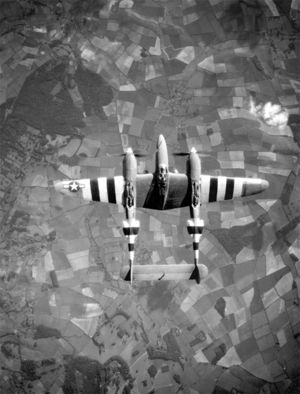
General George C. Kenney, commander of the USAAF Fifth Air Force operating in New Guinea, could not get enough P-38s,[citation needed] though since they were replacing serviceable but inadequate P-39s and P-40s, this might seem like guarded praise. But Lightning pilots began to compete in racking up scores against Japanese aircraft, including one of the most famous missions of the war, the interception, on 18 April 1943, of Admiral Isoroku Yamamoto, the architect of Japan's naval strategy in the Pacific, including the attack on Pearl Harbor. When American codebreakers found out that he was flying to Bougainville Island to conduct a front-line inspection, 16 Lightnings were sent on a long-range mission to intercept and kill Yamamoto: flying 700 km (435 miles) at heights from 3-15 m (10-50 feet) above the ocean to avoid detection. Four actually attacked the bombers, while the other 12 provided top cover. The Lightnings met Yamamoto's Mitsubishi G4M "Betty" bomber and escorting Zero fighters just as they arrived; the G4M was shot down over the jungle.[18]
On 2-4 March 1943, P-38s flew top cover for Fifth Air Force and Australian bombers and attack planes during Battle of the Bismarck Sea, a crushing defeat for the Japanese. Two P-38 aces from the 39th Fighter Squadron were killed on the second day of the battle: Bob Faurot and Hoyt "Curley" Eason (a veteran with five victories who had trained hundreds of pilots, including Dick Bong).
Service record
The P-38's service record shows mixed results. On the negative side, most variants were certainly harder to fly than the best single-engine fighters and in early models, pilots suffered badly from the cold in northern climates. Also, the twin turbocharged Allisons had problems – a good portion of Lightnings were lost during the war due to engine difficulties rather than by enemy gunfire, which contributed to the plane's relatively low kill-ratio. Up until the "J-25" variant, P-38s were often "sitting ducks" to Luftwaffe fighters because of the problematic engines and the lack of dive flaps to counter compressibility in dives. German fighter pilots would often go into steep dives because they knew that the Lightnings would be reluctant to follow.
Although not the best dogfighter, the Lightning's greatest virtues were long range, heavy payload, high speed, fast climb and concentrated firepower. The P-38 was a formidable interceptor and attack aircraft and, in the hands of a good pilot, could be dangerous in air-to-air combat. In the Pacific theater, the P-38 downed over 1800 Japanese aircraft, with more than 100 pilots becoming aces by downing five or more enemy.[18]
Postwar operations
The end of the war left the USAAF with thousands of P-38s, rendered obsolete by the jet-age. Fifty late-model Lightnings were provided to Italy and operated for several years, with a dozen sold to Honduras. The others were put up for sale for $1,200 USD apiece, and the rest were scrapped.
Lockheed test pilot Tony LeVier was among those who bought a P-38, turning it into an air racer. The Lightning was a popular contender in the air races from 1946 through 1949, with brightly colored Lightnings making screaming turns around the pylons.
F-5s were bought by aerial survey companies and used for aerial mapping. From the 1950s on, the use of the Lightning steadily declined, and only a little more than two dozen still exist, with few still flying. One example is a P-38L owned by the Lone Star Flight Museum in Galveston in Texas, painted in the colors of Charles MacDonald's Putt Putt Maru.
Variants
| Variant | Produced | Comment |
|---|---|---|
| XP-38 | 1 | Prototype |
| YP-38 | 13 | Evaluation planes |
| P-38 | 30 | Initial production plane |
| XP-38A | 1 | Pressurized cockpit |
| P-38D | 36 | |
| P-38E | 210 | |
| F-4 | 100+ | recons based on P-38E |
| Model 322 | 3 | RAF planes |
| RP-322 | 147 | USAAF trainers |
| P-38F | 527 | |
| F-4A | 20 | recons based on P-38F |
| P-38G | 1,082 | |
| F-5A | 180 | recons based on P-38G |
| XF-5D | 1 converted F-5A | |
| P-38H | 601 | |
| F-5C | 123 | based on P-38H |
| P-38J | 2,970 | new radiator style |
| F-5B | 200 | based on P-38J |
| F-5E | 605 | P-38J/L conversion |
| P-38K | 1 | paddle props |
| P-38L-LO | 3,810 | |
| P-38L-VN | 113 | |
| F-5F | based on P-38L | |
| P-38M | 75 | night-fighter |
| F-5G |
Over 10,000 Lightnings were manufactured in all; it was one of the few combat aircraft that had been in production throughout the entire duration of World War II. The Lightning had a major effect on other aircraft, such as the fact that its wing, in a scaled-up form, was used on the L-049 Constellation.[20]
The first combat-capable Lightning was the P-38E, which featured improved instruments, electrical systems and hydraulic systems. Part-way through production, the older Hamilton Standard Hydromatic hollow steel propellers were replaced by new Curtiss Electric duraluminum propellers. The definitive armament configuration, featuring four 12.7 mm machine guns with 500 rounds per gun and a Hispano 20 mm cannon with 150 rounds instead of the unreliable Oldsmobile 37 mm gun, was standardized.
While the machine guns had been arranged symmetrically in the nose on earlier variants, they were "staggered" in the P-38E and later versions, with the muzzles sticking out of the nose in the relative lengths of roughly 1:4:6:2. This was done to ensure a straight ammunition belt feed into the weapons, as the earlier arrangement led to jamming.
The first P-38E rolled out of the factory in October 1941. Over a hundred P-38Es were completed in the factory or converted in the field to a photo-reconnaissance variant, the F-4, in which the guns were replaced by four cameras. Most of these early reconnaissance Lightnings were retained stateside for training, but the F-4 was the first Lightning to see combat in April 1942. After 210 P-38Es were built, the P-38E was followed, starting in April 1942, by the P-38F, which incorporated racks inboard of the engines for fuel tanks or a total of 2,000 pounds (900 kg) of bombs. A total of 527 P-38Fs were built.
The P-38F was followed in early 1943 by the P-38G, utilizing more powerful Allisons of 1,400 hp (1,040 kW) each and equipped with a better radio. The P-38G was followed in turn by the P-38H, with further uprated Allisons (1,425 hp [1,060 kW] each), an improved 20 mm cannon and a bomb capacity of 3,200 pounds (1,450 kg). These models were also field-modified into F-4A and F-5A reconnaissance aircraft. An F-5A was modified to an experimental two-seat reconnaissance configuration, with additional cameras in the tail booms.
Early variants did not have reputations for being maneuverable aircraft, though they could be agile at low altitudes if flown by a capable pilot, using the P-38's forgiving stall characteristics to their best advantage. From the P-38F-15 model onwards, a "combat maneuver" setting was added to the P-38's Fowler flaps. When deployed at the eight-degree maneuver setting, the flaps allowed the P-38 to out-turn many contemporary single-engined fighters at the cost of some added drag. The addition of hydraulically-boosted ailerons, starting from the P-38J-25, also improved roll rate and response.
Lightning in maturity: P-38J, P-38L
The definitive P-38J was introduced in August 1943. The turbocharger intercooler system on previous variants had been housed in the leading edges of the wings and had proven vulnerable to combat damage and could explode if the wrong series of controls were mistakenly activated. In the newest variant, the streamlined twin booms of previous Lightnings was changed to fit the intercooler radiators placed under the prop hub at the front of the booms, forming a "chin" that made the P-38J visibly different from its predecessors. The space left open in the wings was replaced with fuel tanks, further increasing the aircraft's long range. The revised radiator configuration made cooling much more efficient and improved both performance and reliability.
Late production P-38Js also finally ameliorated the compressibility problem through the introduction of minor aerodynamic changes, particularly the addition of a set of small dive flaps just outboard of the engines on the bottom centerline of the wings. With these improvements, a USAAF pilot reported a dive speed of almost 600 miles per hour (970 km/h), although the reported air speed was later corrected for compressibility error, and the actual dive speed was lower.[21]
Finally, later production of the P-38J was equipped with power-boosted flight controls, one of the first times such a system was fitted to a fighter, and did much to improve the Lightning's roll rate at high speeds and maneuverability. With a truly satisfactory Lightning in place, Lockheed ramped up production, working with subcontractors across the country to produce hundreds of Lightnings each month.
There were two P-38Ks developed in 1942–1943. The first was a modified P-38E test mule fitted with paddle bladed "high activity" Hamilton Standard propellers similar to those used on the P-47. The aircraft also received the new intercoolers developed for the P-38J. The prototype's performance led to the development on the second aircraft—a modified P-38G (re-designated P-38K-1-LO) fitted with the aforementioned propellers and a new Allison engine with 100 more bhp than even the later P-38L. In tests it was rated at 432mph in military power and predicted to exceed 450 mph in war emergency power with a similar increase in rate of climb, load, ceiling and range. However, the War Production Board refused to authorize P-38K production due to the two to three-week shutdown of the production line needed to redesign the cowlings to accommodate the new engine.
The P-38L was the most numerous variant of the Lightning, with 3,923 built, 113 by Consolidated-Vultee in their Nashville plant. It entered service with the USAAF in June of 1944, in time to support the Allied invasion of France on D-Day. Lockheed production of the Lighting was distinguished by a suffix consisting of a production block number followed by "LO," for example "P-38L-1-LO", while Consolidated-Vultee production was distinguished by a block number followed by "VN," for example "P-38L-5-VN."
The P-38L was the first Lightning fitted with zero-length rocket launchers. Seven HVARs (high velocity aircraft rockets) on pylons beneath each wing, later ten rockets on each wing on "Christmas tree" launch racks. The P-38L also had strengthened stores pylons to allow carriage of 2,000 pound (900 kg) bombs or 300 US gallon (1,140 liter) drop tanks.
Lockheed modified 200 P-38J airframes in production to become unarmed F-5B photo-reconnaissance aircraft, while hundreds of other P-38Js and P-38Ls were field-modified to become F-5Es, F-5Fs, and F-5Gs. A few P-38Ls were field-modified to become two-seat TP-38L familiarization trainers.
Late model Lightnings were delivered unpainted, as per USAAF policy established in 1944. At first, field units tried to paint them, since pilots worried about being too visible to the enemy, but it turned out the reduction in weight was a minor plus in combat.
The P-38L-5—the most common sub-variant of the P-38L—had a modified cockpit heating system which consisted of a plug in the cockpit in which the pilot would plug his heat-suit wire, giving him more comfort. As well, P-38Ls were fitted with hydraulically operated dive flaps and ailerons, giving them better handling at higher speeds. These Lightnings also received the uprated V-1710-111/113 (F30) engines, and this dramatically lowered the amount of engine failure problems experienced at high altitude.
Pathfinders, Night Fighter, and other oddballs
The Lightning was modified for other roles. In addition to the F-4 and F-5 reconnaissance variants, a number of P-38Js and P-38Ls were field-modified as formation bombing "pathfinders" or "droopsnoots", fitted with a glazed nose with a Norden bombsight, or a H2X radar "bombing through overcast" nose. A pathfinder would lead a formation of other P-38s, each overloaded with two 900 kg (2,000 pound) bombs; the entire formation would release when the pathfinder did.
A number of Lightnings were modified as night fighters. There were several field or experimental modifications with different equipment fits that finally led to the "formal" P-38M night fighter, or Night Lightning. Seventy-five P-38Ls were modified to the Night Lightning configuration, painted flat-black with conical flash hiders on the guns, an AN/APS-6 radar pod below the nose, and a second cockpit with a raised canopy behind the pilot's canopy for the radar operator. The headroom in the rear cockpit was limited, requiring radar operators who were preferably short in stature.
The additional external clutter imposed surprisingly little penalty on the P-38M's performance; it was faster than the purpose-built Northrop P-61 Black Widow night fighter. The Night Lightnings saw some combat duty in the Pacific towards the end of the war, but, verifiably, none engaged in combat.
One of the initial production P-38s had its turbochargers removed, with a secondary cockpit placed in one of the booms to examine how flightcrew would respond to such an "asymmetric" cockpit layout. One P-38E was fitted with an extended central nacelle to accommodate a tandem-seat cockpit with dual controls, and was later fitted with a laminar flow wing.
Very early in the Pacific War, a scheme was proposed to fit Lightnings with floats to allow them to make long-range ferry flights. The floats would be removed before the aircraft went into combat. There were concerns that salt spray would corrode the tailplane, and so one P-38E was modified with a raised tailplane and a rearward-facing second seat for an observer to monitor the effectiveness of the new arrangement. This P-38E was not actually fitted with floats, and the idea was quickly abandoned as the US Navy proved to have enough sealift capacity to keep up with P-38 deliveries to the South Pacific.
Still another P-38E was used in 1942 to tow a Waco troop glider as a demonstration. There proved to be plenty of other aircraft, such as C-47s, available to tow gliders, and the Lightning was spared this duty.
Standard Lightnings were even used as crew and cargo transports in the South Pacific. They were fitted with pods attached to the underwing pylons, replacing drop tanks or bombs, that could carry a single passenger in a lying-down position, or cargo. This was a very uncomfortable way to fly. Some of the pods weren't even fitted with a window to let the victim see out or bring in light. One fellow who hitched a lift on a P-38 in one of these pods later said that "whoever designed the damn thing should have been forced to ride in it."
Lockheed proposed a carrier-based Model 822 version of the Lightning for the United States Navy. The Model 822 would have featured folding wings, an arresting hook, and stronger undercarriage for carrier operations. The Navy wasn't interested, as they regarded the Lightning as too big for carrier operations and didn't like liquid-cooled engines anyway, and the Model 822 never went beyond the paper stage. However, the Navy did operate four land-based F-5Bs in North Africa, with these aircraft inherited from the USAAF and redesignated FO-1.
A P-38J was used in experiments with an unusual scheme for mid-air refueling, in which the fighter snagged a drop tank trailed on a cable from a bomber. The USAAF got this to work, but decided it wasn't practical. A P-38J was also fitted with experimental retractable snow ski landing gear, but this idea never reached operational service either.
After the war, a P-38L was experimentally fitted with armament of three 15.2 mm (0.60 in) machine guns. The 15.2 mm cartridge had been developed early in the war for an infantry "anti-tank rifle," a type of weapon developed by a number of nations in the 1930s when tanks were lighter but, by 1942, the idea of taking on a tank with a large-caliber rifle was somewhere between "outdated" and "suicidal."
The cartridge wasn't abandoned, with the Americans designing a derivative of the German MG 151 15 mm machine gun around it and designating the weapon the "T17," but though 300 of these guns were built and over six million 15.2 mm rounds were manufactured, they never worked out all the bugs, and the T17 never saw operational service. The cartridge was "necked up" to fit 20 mm projectiles and became a standard US ammunition after the war. The T17-armed P-38L did not go beyond unsuccessful trials.
Another P-38L was modified after the war as a "super strafer," with eight 12.7 mm machine guns in the nose and a pod under each wing with two 12.7 mm guns, for a total of 12 machine guns. Nothing came of this conversion, either.
Military operators
Wartime
- Template:AUS: RAAF[22]
 China: National Revolutionary Army - flew 15 P-38Js and P-38Ls and, postwar, they also received a similar number of F-5Es and F-5Gs.[22]
China: National Revolutionary Army - flew 15 P-38Js and P-38Ls and, postwar, they also received a similar number of F-5Es and F-5Gs.[22]- Template:FRA - Free French operated F-5As in Group 2/23[23]
 Germany: Luftwaffe (captured)
Germany: Luftwaffe (captured) Italy - A single P-38G was captured intact by the Italians during the war when the pilot accidentally landed at an Italian base. This Lightning was flown in combat against Allied aircraft, but was quickly grounded due to lack of parts. After capitulation, the Italian Air Force flew F-5A photo-reconnaissance missions with 3rd Aerobrigata RT and 4th Aerobrigata [24]
Italy - A single P-38G was captured intact by the Italians during the war when the pilot accidentally landed at an Italian base. This Lightning was flown in combat against Allied aircraft, but was quickly grounded due to lack of parts. After capitulation, the Italian Air Force flew F-5A photo-reconnaissance missions with 3rd Aerobrigata RT and 4th Aerobrigata [24]- Template:POR - Two Lightnings that were forced to land in Lisbon, Portugal, while on a ferry flight from England to Algeria were interned and operated by the Portuguese.[22]
- Template:USSR
- Template:UK: (RAF evaluation only)[22]
- Template:USA
- A P-38L was modified by Hindustan Aeronautics in India as a fast VIP transport, with a comfortable seat in the nose, leather-lined walls, accommodations for refreshments and a glazed nose to give the passenger a spectacular view.
Postwar
- Template:DOM
- Template:ITA - 50 late model planes
- Template:HON - 12 planes
P-38s in Popular Culture
The Lockheed P-38 has been the "star" of a number of contemporary movies including:
- A Guy Named Joe (1943) has Spencer Tracy returning as a guiding spirit looking after young P-38 pilot Van Johnson.
- Flight Characteristics of the Lockheed P-38 Lightning (1943, color, 34:00). Lockheed's top World War II test pilots do the checkout on this very thorough pilot training film. * Yamamoto shot down! (1944, B&W, 4:00) The P-38 Squadron that shot down Admiral Yamamoto in an incredible long distance interception in the Pacific, is depicted. The film includes purported P-38 gun camera footage of the Admiral's Betty bomber going down in flames.
- Dick Bong: Pacific Ace (1944, B&W, 4:00) This short documentary film pays tribute to Richard "Dick" Bong, the leading American P-38 ace of World War II.
- P-38 Reconnaissance Pilot (1944, B&W, 29.00) Starring William Holden as Lt. "Packy" Cummings, this short feature shows that photo recon pilots (photo Joes) had one of the riskiest, highest impact jobs in the war.
- Angel in Overalls (1945, B&W, 15:00) This film was developed to show US Lockheed P-38 production line workers in a wide variety of roles.
- Come and See (1985) features a P-38 Lightning flying continuously over troops.
- Aces: Iron Eagle III (1992) features a P-38 as the lead fighter, piloted by Louis Gossett Jr. as "Chappy Sinclair" in a modern-era war against drug traffickers.
The P-38 has also been the hero aircraft in the Capcom shooter arcade game 1942, and has appeared in every game in that series since then.
Noted or surviving P-38s
The 5,000th Lightning built, a P-38J, was painted bright vermillion red, and had the name "YIPPEE" painted on the underside of the wings in big white letters as well as the signatures of hundreds of factory workers. This aircraft was used by Lockheed test pilots Milo Burcham and Tony LeVier in remarkable flight demonstrations, performing such stunts as slow rolls at treetop level with one prop feathered to show that the P-38 was not the unmanageable beast of legend. Their exploits did much to reassure pilots that the Lightning might be a handful, but it was no "widow maker."
P-38F s/n 417630 (now called "Glacier Girl") was one of six P-38 fighters and two B-17 bombers being flown to Europe seven months after the United States entered World War II. While enroute over Greenland, bad weather caused the eight aircraft to turn back, the entire flight attempting to land together before they ran out of fuel. Although one P-38 overturned, the flight successfully belly-landed. The crews were rescued within a few days, but the airplanes were abandoned and, over the years, they were covered by ice. A few attempts to salvage the airplanes were made but were unsuccessful.
Eventually, Roy Shoffner, a Middlesboro, Kentucky businessman, acquired the salvage rights and in 1992, 50 years and one month after the planes landed, a P-38 recovery mission was undertaken. Using photos taken by the original crews while they were awaiting rescue as well as modern seismographic equipment, the salvage workers located the buried squadron and selected the least damaged of the planes. They reached it by boring a hole using hot water through the layer of ice 268 feet thick. The airplane was transported to Middlesboro, where a ten-year restoration began using many parts from late model aircraft. Nicknamed "Glacier Girl," the restored P-38F Lightning made its first post-restoration flight on 26 October 2002.[25]
Noted P-38 pilots
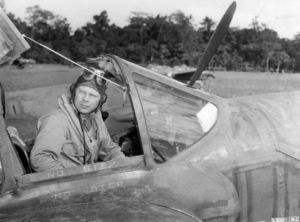
P-38 pilots racked up big scores against the Japanese. Richard I. "Dick" Bong and Thomas J. "Tommy" McGuire of the USAAF competed for the top position, a rivalry made interesting by the contrast in personalities of the two men. Both Bong and McGuire were unbelievably aggressive and fearless in the air. After dogfights, their P-38s would be warped out of shape by overstress. On the ground, they were completely different men. Dick Bong was a modest, quiet, almost shy man, while the egotistical McGuire was "an unpleasant individual with a talent much bigger than he was," as one of his colleagues remembered him.
Bong was rotated back to the States as America's ace of aces, after making 40 kills. He was killed on 6 August 1945, the day the atomic bomb was dropped on Japan, when his P-80 Shooting Star jet fighter flamed out on take-off. McGuire had been killed in air combat in January 1945, over the Philippines, after racking up 38 confirmed kills, making him the second-ranking American ace. Both men were awarded the Medal of Honor.
The famed aviator, Charles Lindbergh, worked in the South Pacific for Lockheed as an operational test pilot, where he shot down at least one Japanese aircraft with his P-38. He was instrumental in extending the range of the P-38 through improved throttle settings, or engine-leaning techniques, notably by reducing engine RPM to 1600 rpm, which had prior been considered dangerous, because it was thought this would upset the fuel mixture and cause an explosion.[26]
The seventh-ranking American ace, Charles MacDonald, also flew a Lightning against the Japanese, scoring 27 kills in his famous aircraft, the "Putt Putt Maru."
A P-38 piloted by Clay Tice was the first American aircraft to land in Japan after VJ-Day, when he and his wingman set down on Nitagahara because his wingman was low on fuel.[citation needed]
Since F-5s operated alone, when their missions went wrong, they generally disappeared without a trace. The noted aviation pioneer and writer Antoine de Saint-Exupery vanished in an F-5 while on a reconnaissance mission over Lyon, France, on 31 July 1944. recently, a French scuba diver found the wreckage of a Lightning in the Mediterranean off the coast of Marseille in 2000, and it was confirmed in April 2004 as Saint-Exupery's.
The RAF's legendary photo-recon "ace," Wing Commander Adrian Warburton DSO DFC, was the pilot of a Lockheed F-5B borrowed from the USAAF that took off on 12 April 1944 to photograph targets in Germany. W/C Warburton failed to arrive at the rendezvous point and was never seen again. In 2003, his remains were recovered from his wrecked USAAF F-5B Lightning in Germany.
Specifications (P-38L)
Data from Quest for Performance[27]
General characteristics
- Crew: One
- Length: 37 ft 10 in (11.53 m)
- Wingspan: 52 ft 0 in (15.85 m)
- Height: 9 ft 10 in (3.00 m)
- Wing area: 327.5 ft² (30.43 m²)
- Airfoil: NACA 23016 / NACA 4412
- Empty weight: 12,780 lb (5,800 kg)
- Loaded weight: 17,500 lb (7,940 kg)
- Max takeoff weight: 21,600 lb (9,798 kg)
- Powerplant: 2× Allison V-1710-111/113 liquid-cooled turbosupercharged V-12, 1,600 hp (1,194 kW) each
- Zero-lift drag coefficient: 0.0268
- Maximum speed: 414 mph at 25,000 ft (667 km/h at 7,620 m)
- Stall speed: 105 mph (170 km/h)
- Range: 1,100 mi combat, 2,600 mi ferry (1,770 km / 3,640 km)
- Service ceiling: 44,000 ft (13,400 m)
- Rate of climb: maximum: 4,750 ft/min (1,448 m/min)
- Wing loading: 53.4 lb/ft² (260.9 kg/m²)
- Power/mass: 0.16 hp/lb (0.27 kW/kg)
- 1x Hispano M2(C) 20 mm cannon with 150 rounds (2 AP, 2 tracer and 2 HE ammo belt composition) and 4x Colt-Browning MG53-2 0.50 in (12.7 mm) machine guns with 500 rounds per gun. The rate of fire was about 650 rounds per minute for the 20x110 mm cannon round (130 g shell) at a muzzle velocity of about 880 m/s, and for the 12.7x99 mm MGs (43-48 g), about 850 rpm at 840 m/s velocity.
- 4x M10 three-tube 4.5 in (112 mm) rocket launchers or:
- 10x 5 in (127 mm) HVAR's (High Velocity Aircraft Rocket) and/or:
- either 2x 2,000 lb (908 kg) or 2x 1,000 lb (454 kg), 4x 500 lb (227 kg) or 4x 250 lb (114 kg) bombs
References
- ↑ 1.0 1.1 1.2 Donald, David, ed. "Lockheed P-38 Lightning." The Encyclopedia of World Aircraft. Etobicoke, Ontario, Canada: Prospero Books, 1997. ISBN 1-85605-375-X.
- ↑ Knaack, Marcelle Size. Encyclopedia of US Air Force Aircraft and Missile Systems: Volume 1 Post-World War II Fighters 1945-1973. Washington, DC: Office of Air Force History, 1978. ISBN 0-912799-59-5.
- ↑ P-38 Lightning. [1] Access date: 21 January 2007.
- ↑ Lockheed P-38 Lightning. [2] Access date: 21 January 2007.
- ↑ Development of the P-38. [3] Access date: 21 January 2007. Quote = The page contains a link to a digram of the configurations considered: [4].
- ↑ 6.0 6.1 6.2 Lockheed P-38 Lightning - USA. [5] Access date: 21 January 2007.
- ↑ O'Leary, Michael. "Conquering the Sky!" Air Classics, April 2005. [6]. Access date: 26 January 2007.
- ↑ 8.0 8.1 8.2 8.3 Lockheed P-38J Lightning. [7] Access date: 23 January 2007.
- ↑ Early Years. [8] Access date: 21 January 2007.
- ↑ Baugher, Joe. Lockheed YP-38 Lightning. [9]. Access date: 29 January 2007.
- ↑ "Goebel, Greg. The Lockheed P-38 Lightning Version 1.3.[10] Access date: 21 January 2007.
- ↑ Baugher, Joe. Lockheed P-38 Lightning. [11]. Access date: January 29, 2007.
- ↑ Baugher, Joe. Lockheed XP-38A Lightning. [12]. Access date: 29 January 2007.
- ↑ Baugher, Joe. Lockheed P-38D Lightning. [13]. Access date: 29 January 2007.
- ↑ Baugher, Joe. Lightning I for RAF. [14]. Access date: 29 January 2007.
- ↑ 16.0 16.1 16.2 Baugher, Joe. P-38 in European Theatre. [15]. Access date: 04 February 2007.
- ↑ Stanaway, John C. P-38 Lightning Aces of the ETO/MTO. New York: Osprey, 1997. ISBN 1-85532-698-1.
- ↑ 18.0 18.1 Stanaway, John C. P-38 Lightning Aces of the Pacific and Cbi. Pg. 14. New York: Osprey, 1997. ISBN 1855326337.
- ↑ Lockheed P-38 Lightning. [16] Access date: 23 January 2007
- ↑ Johnson, Clarence L. "Kelly". Kelly: More Than My Share of it All. Washington, DC: Smithsonian Books, 1985. ISBN 0-87474-491-1.
- ↑ Baugher, Joe. Lockheed P-38J Lightning. [17]. Access date: 29 January 2007.
- ↑ 22.0 22.1 22.2 22.3 Baugher, Joe. P-38s with US Navy and Foreign Air Forces. [18]. Access date: 06 February 2007.
- ↑ Bodie, 1991, p.240.
- ↑ Bodie, 1991, p.240.
- ↑ Glacier Girl. [19] Access date: 21 January 2007.
- ↑ Kirkland 2003, p. 29-35.
- ↑ Loftin, L.K. Jr. Quest for Performance: The Evolution of Modern Aircraft. NASA SP-468. [20] Access date: 22 April 2006.
- Abela, Stephen. Airfield Tales: Lincolnshire’s wartime legacy. (Video documentary), 2006.Airfield Tales: Lincolnshire’s wartime legacy
- Caidin, Martin. Fork-tailed Devil. New York: Ballantine Books, 1983. ISBN 0-345-31292-9.
- Cain, Charles W. and Jerram, Mike. Fighters of World War II. New York: Exeter Books, 1979. ISBN 0-89673-026-3.
- Christy, Joe and Ethell, Jeffrey L. P-38 Lightning at War. New York: Scribners,1977. ISBN 0-684-15740-3.
- Dorr, Robert F. and Donald, David. Fighters of the US Air Force: From World War I Pursuits to the F-117. New York: Military Press, 1990. ISBN 0-517-66994-3.
- Ethell, Jeffrey L. P-38 Lightning in World War II Color. St. Paul, Minnesota: Motorbooks International, 1994. ISBN 0-87938-868-4.
- Francillon, René J. Lockheed Aircraft since 1913. Annapolis: Naval Institute Press, 1987. (Originally published by Putnam Aeronautical Books, London). ISBN 0-97021-897-2.
- Gunston, Bill. Aircraft of World War II. New York: Crescent Books, 1980. ISBN 0-517-31680-3.
- Gunston, Bill. The Illustrated History of Fighters. New York: Pocket Books, 1981. ISBN 0-671-05655-7.
- Kirkland, Richard. War Pilot: True Tales of Combat and Adventure. New York: Ballantine Books, 2003. ISBN 0-34545-812-5.
External links
- United States Air Force Museum P-38 page
- Usaaf.com P-38 photos
- The Flying Bulls P-38 Restoration at Ezell Aviation
- Lost Squadron Museum, home of "Glacier Girl," a P-38 recovered and restored to flying condition after being embedded in ice for 50 years
- P-38 Lightning Online: photos, pilots, strategies, the good and the bad about the famed Lightning
- P-38 National Association and Museum
- Whatever happened to the Lockheed P-38K?
Related content
Related development
Comparable aircraft
Configuration
Performance
Designation sequence
- Pre-1948 USAAC/F:
- 1922-1962 Navy :
- Post-1948 USAF:
Related lists
Airliners and Civil Transports: Vega · Electra · Electra Junior · Super Electra · Lodestar · Constellation · Saturn · L-188 Electra · L-402 · JetStar · L-1011 TriStar
Military Transports : C-64 · C-121 · R6V · C-130 Hercules · C-141 Starlifter · C-5 Galaxy
Fighters: F-22 Raptor · F-35 Lightning II · F-94 Starfire · F-104 Starfighter · F-117 Nighthawk · P-38 Lightning · P-80 Shooting Star · T-33 Shooting Star
Patrol and reconnaissance : Hudson · PV-1 Ventura · PV-2 Harpoon · P-2 Neptune · P-3 Orion · CP-140 Aurora/CP-140A Arcturus · U-2 · SR-71 Blackbird · S-3 Viking
Lists relating to aviation | |
|---|---|
| General | Timeline of aviation · Aircraft · Aircraft manufacturers · Aircraft engines · Aircraft engine manufacturers · Airports · Airlines |
| Military | Air forces · Aircraft weapons · Missiles · Unmanned aerial vehicles (UAVs) · Experimental aircraft |
| Notable incidents and accidents | Military aviation · Airliners · General aviation · Famous aviation-related deaths |
| Records | Flight airspeed record · Flight distance record · Flight altitude record · Flight endurance record · Most produced aircraft |
cs:P-38 Lightning de:Lockheed P-38 es:P-38 Lightning fr:Lockheed P-38 Lightning it:Lockheed P-38 Lightning he:P-38 לייטנינג nl:P-38 Lightning ja:P-38 (戦闘機) no:Lockheed P-38 Lightning pl:Lockheed P-38 Lightning pt:P-38 Lightning fi:P-38 Lightning zh:P-38战斗机
